Approved STSMs 2015
Approved STSMs 2015
Second Year STSMs
The COST Action FA1301 – CephsInAction granted till now 12 STSMs!
This provides about 40% more supported Missions than originally planned.
The selection was operated according to defined criteria
These serve to support the exchange of researchers to establish new areas of scientific collaboration within the areas of activities of FA1301 COST Action.
The STSMs 2015 call solicited to two different “kinds” of STSM-projects based on:
- prioritized research themes related with the “research needs” of different WGs
- open themes:
Establishing of the optimal conditions for eggs incubation, and hatchling health fitness in decapod and octopods species
Examination of natural living conditions of selected cephalopod species, towards defining optimal conditions for their husbandry
Selection of biomarkers as candidates of welfare and health assessment for cephalopods
Neurophysiological research in cephalopods
Exploring anesthesia and analgesia methodology in cephalopods to refine and deepen species-specific physiological requirements
Working towards a semantic modelling of Cephalopod Welfare
Short 2015 STSM Summary Reports
Dr. Piero Amodio: Two novel methodological approaches to investigate the social behaviour of the octopus in the wild
Show More/Less
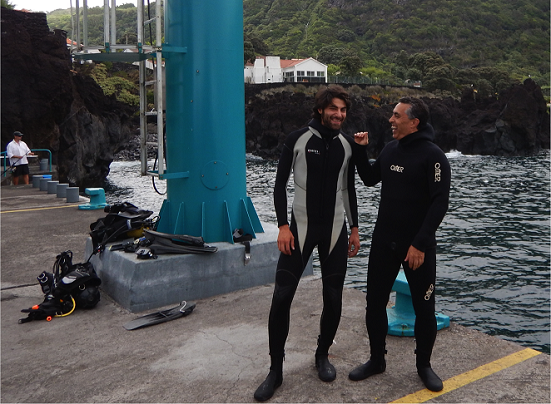
Period from 01/06/2015 to 02/08/2015
Full name: Piero Amodio
Home Institution: Stazione Zoologica Anton Dohrn, Napoli (IT)
Host Institution: Department of Oceanography and Fisheries, University of Azores, Horta (PT)
STSM Summary Report
Research Interest: Cephalopods behaviour and cognition.
Summary of research completed during STSM: The present study was aimed to test two novel methodological approaches to investigate the social behaviour of the common octopus, Octopus vulgaris, in the wild. The first method tested the behavioural response triggered by the sight of a potential conspecific octopus in the wild. Two kinds of stimuli (50×20 cm) were used: a mirror (Experimental Stimulus) that provide a reflected image of the surrounding including the animal; an opaque plastic board (Control Stimulus) that do not reflect any feature of the surrounding. Octopuses were located through SCUBA diving surveys. Subsequently, the mirror or board was selected at random and it was presented to the animal (30 cm from the entrance of the den). After approximately 20 minutes, the first stimulus was removed and the other stimulus presented for the same amount of time. Octopus’ response was video-recorded through an underwater camera. Seventeen octopuses of both sexes and of distinct weight-range classes were tested during the study. In seven cases however, experimental videos were not analysed due to potentially biasing conditions (i.e. presence of predators). Octopuses’ attentiveness was substantially higher during experimental sessions with the mirror than in control sessions. Small size animals were less prone to physically explore the mirror (but not the plastic board) than bigger size conspecifics. With a single exception, self-directed behaviours (grooming and cleaning manoeuvre) were performed by big size octopuses in response to the mirror. Concerning body patterns, camouflage was commonly triggered by both stimuli in small size octopuses, while it was rarely observed in bigger animals. The fighting display was expressed just by big size octopuses toward the mirror. Unilateral was performed by octopuses belonging to distinct weight-range classes. Passing clouds and Dymantic were never observed during the experiment. The second method aimed to observe, using remote gear from a boat, spontaneous social interactions between two octopuses occupying neighbouring dens. As preliminary phase, the study area was enriched with artificial dens (plastic pots: 35x10x10cm). Four pots were arranged in two distinct observation spots. In each spot, two artificial dens were placed in close proximity (< 1m) and with their openings opposing each other. During the following two weeks, the presence of octopuses in the artificial dens was monitored through surveys. Unfortunately, artificial dens were never selected as shelters by octopuses. Hence, no observation from remote was conducted. It is probable that the negative results obtained may be due to short duration of the experiment or by the small number of dens utilized. In order to increase the chances of success for this experiment, an additional strategy may be to select soft sediment areas rather than rocky bottom areas, as field site. Since dens availability is a limiting resource in the former sites, the weaker presence of natural dens may results in higher probability of occupancy of artificial dens in soft sediment areas.
Synthesis and application of research: This study demonstrated that the experiment with the mirror is suitable approach to investigate the social behaviour of the octopus in the wild. This method allows the measurement of attentiveness, exploratory such as inhibitory drive triggered by the sight of a conspecific. Further it may also be a powerful tool to describe the body pattern repertoire of a species and to highlight intraspecific differences. On the other hand, results obtained do not allow to draw solid conclusions about the applicability of the method used to observe spontaneous social interactions of octopuses through a remote gear. Further longer-term study should also investigate whether this method is more suitable for soft sediment field sites.
Wider benefit of the STSM to the participant: The STSM sponsored by the COST Action FA1301 CephsInAction was a precious opportunity for my education, since it allowed me to devise and to conduct my first field study in a marine environment. Through this project and thanks to the excellent facilities provided by the Department of Oceanography and Fisheries at the University of Azores in Horta (DOP/IMAR), I could test some of the methods I may use in my future research and I could evaluate their limits and applicability. Under the wise guidance of Dr. Joao Goncalves, I also improved my skills as scuba diver and I acquired a deeper practical knowledge to conduct behavioural investigation in the wild. Finally, the numerous observations performed during my stay in Horta increased significantly my understanding of octopus’ behaviour in the wild.
Key output: octopus, social behaviour, mirror, observation from remote
Dr. Jay J Culligan: Construction of an open source database for cephalopod patterns
Show More/Less
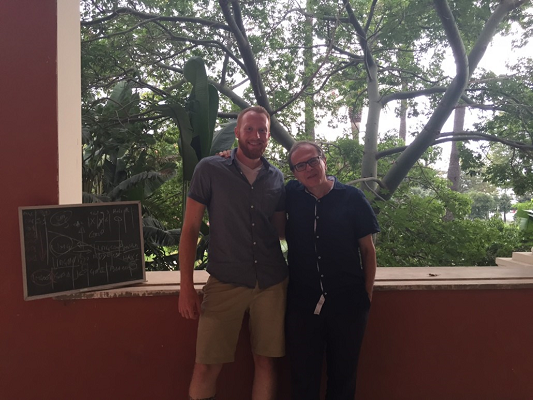
Period from 28/08/2015 to 04/09/2015
Full name: Jay J Culligan
Home Institution: University of Sussex, Brighton, UK
Host Institution: Stazione Zoologica Anton Dohrn, Napoli, Italy
STSM Summary Report
Research Interest: Cephalopod dynamic colour-change and camouflage.
Summary of research completed during STSM: We constructed an open source database for cephalopod patterns. The current focus begins with cuttlefish patterns, but will eventually encompass all cephalopod species.
The project optimized the database to ensure the reference data and structure are compatible with the classic cephalopod contributions and the COST Action. We configured the database to ensure the classification scheme is widely usable. Main effort has been given to facilitate tagging of the images to include the relevant descriptors, making filtering easier and smoother. The method used is similar to the Medical Subject Headings (MeSH) system, used by the National Library of Medicine.
In the database reference information is grouped together within look-up tables. These are constructed to contain data specific to a single category and designed according to the best practice for SQL-based relational databases. Other information is supposed to be collected in defined FIELDS having adequate characteristics. A hierarchical design is applied to allow tables linked through “relationships”
In the image database, we implemented two parallel hierarchies: “images” and “authors”.
Images table is linked to multiple child (lookup) tables that allow additions to each image standardized metadata about species-specific habitat, phylogeny, etc. In addition, look-up tables have been defined to allow standardized annotation of patterns exhibited by the animal in the conditions “frozen” by the image.
This allows information for a single image being encoded to specific entries based on values provided in the lookup tables and derived from classic cephalopod literature.
The author “tree” is linked to specific sets of experiments and the associated conditions. This allows a user to specify the exact properties – whenever appropriate – of each experiment and/or condition, allowing more refined search queries.
The image and author tables are not mutually exclusive trees. They are parallel, calling on specific sets of information from one another. Authors call on the specific images associated with the experiments and their conditions, and images call on author and experimental conditions.
The final “product” is available at: http://cutttlefish.lifesci.sussex.ac.uk.
Synthesis and application of research: The database provides a unique opportunity at understanding the broader scope of cephalopod patterning. With the phylogenetic content and habitat information analyses can examine the range of patterns, their diversity and explore possible regional variations and pattern similarity across evolutionary branches. The image database will also offer annotated images to more in-depth image-analysis approaches based on different algorithms thus further extending its capabilities and purposes.
The current database hosted at Sussex University will only include cuttlefishes, however we have developed the database to encompass images from all cephalopod species with the aim to provide this as a tool for the broad COST FA1301 community and beyond.
Additionally, the database can be utilized by any researcher to filter images in specific contexts. This reduces the need for experimental duplication and increases data accessibility.
Wider benefit of the STSM to the participant: This project will build onto the paper “Decoding the cuttlefish language: using human language models to decode cuttlefish patterns” (Culligan et al., in preparation). This paper compares the visual similarities between Sepia officinalis body patterns, using an objective, machine learning approach, with the aim of understanding the language-like properties of cuttlefish visual signaling. Additionally, we plan to use the database to capture the full pattern repertoire of the common cuttlefish (Sepia officinalis) as observed in different contexts. Our current database is a small-medium size and machine-learning algorithms are data hungry. We need a large database with thousands of images. Instead of replicating numerous experiments, the database will allow our team to process many experimental conditions from a range of cuttlefish species in various contexts.
Key output: A functional, user-friendly image database, with future opportunities for large data analyses.
Dr. Raquel Fernãndez Gago:A preliminary study of the digestive gland of Octopus vulgaris paralarvae as a new nutritional conditional index
Show More/Less
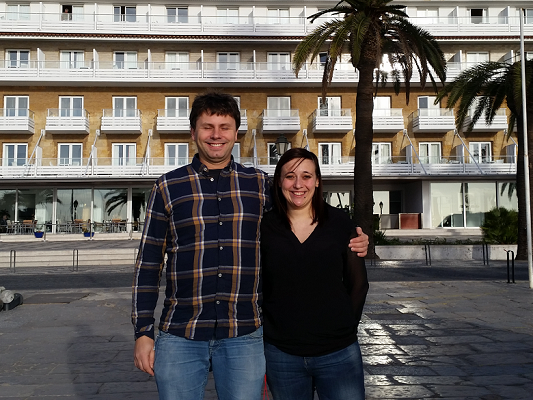
Period from 01/06/2015 to 02/08/2015
Full name: Raquel Fernández Gago
Home Institution: Universidad de Vigo, Spain
Host Institution: Institute of Marine Research Havforsknings Instituttet
STSM Summary Report
Research Interest: A preliminary study of the digestive gland of Octopus vulgaris paralarvae as a new nutritional conditional index.
Summary of research completed during STSM: The most critical period in Octopus vulgaris Cuvier, 1797 culture correspond to the first days after hatching. During this period the paralarvae must start to eat and the food must have the correct nutritive quality (Iglesias et al. 2007). The development of viable and sustainable paralarvae culture techniques requires a deep knowledge of the critical aspects of larval nutrition in relation to the development of the digestive and metabolic system (Gisbert, Ortiz-Delgado & Sarasquete 2008). The low availability of food or inadequate food results in high mortalities (Hunter 1976) or larvae with low nutritional value (Theilacker & Yoshiro 1989). In the last years a lot of researches have been developed in order to know the nutritional requirements for the paralarvae (Navarro 2000; Navarro 2003; Iglesias et al. 2006; Iglesias et al. 2007; Guinot et al. 2013). Despite these researches there isn’t an adequate diet for the paralarvae.
A conditional index useful to establish the welfare and health of the animals (Catalán 2003) can be a powerful tool for ecophysiological studies. Some animal organs or parts could be modified when it suffer starvation whereas others parts are less sensitive (Ferron 1997). In this sense, a condition index that can establish when the paralarvae eat could be a goal in the aquaculture of cephalopods species. This index should be easy to measurement, have a short processing time and low cost. If the index can be also measured in live paralarvae using no invasive methods and avoiding the paralarva sacrifice, the value of this tool will be immense for aquaculture.
The larvae accessory glands have been used as a nutritional biomarker, because it presents different mechanisms in response to the quantity and quality of food (Gisbert, Ortiz-Delgado & Sarasquete 2008). The digestive gland of the paralarvae is easy to see through the transparent mantle of this. For this reason it is an easily measurable structure in this phase of life of the animal. This characteristic could do this structure one of the most important in order to the known the state of the paralarvae.
The colour of the digestive gland of Octopus vulgaris could vary from green and brown colour depending on the diet (Guerra 1978). This would indicate that the colour of the digestive gland is directly related to the diet. It is known that in the cephalopods the digestive gland function is related with the digestive process. This gland not only produced the enzymes necessaries for the digestion, but also it seem to be able to stores the waste products of this process in large vacuoles. This are called for a lot of the authors by Brown bodies. Because are a big vacuoles with brown colour into to the cytoplasm of the cells.
This study aims to establish whether the digestive gland undergoes visual modifications after the paralarvae have been fed. This presents the visual differences in the digestive gland between fed and unfed paralarvae which allows us to know something as important as our paralarvae are eating in culture. We performed the measurement of the relative area of the dark region in the digestive gland of the paralarvae. We have made this step manually and automatically. The manual selection of the regions of interest (ROIs) has been done in the Imagej program. The Manual and automatic measurements have been made using the Matlab 2015R program. We also have done measurements of the brightness mean in the digestive gland of the paralarvae.
Our results show that all the paralarvae have a dark area in the digestive gland, and that this area is bigger in paralarva that have eaten than in starved paralarva. This was also seen as a distinct darkening of the digestive gland of the paralarvae who had fed compared to the unfed paralarvae. This study reports a good tool in order to know when the paralarvae are eating in the culture.
Synthesis and application of research: During research carried out in Bergen we have measured the dark area and brightness mean in the digestive gland in order to know the differences between the starvation and feeded paralarvae. This study lets us know the state of the paralarvae when it is in the tank of culture. The application of this easy tool could improve the aquaculture healthy of the paralarvae. It represents a goal in the maintenance of the paralarvae, because only with an image we could know if the diet is accepted by the paralarvae. Despite of the existence of abundant studies on the cultivation of cephalopod few are the tools developed for a better understanding of the status of these during it. It could be the start point for the development of this kind of tools.
Wider benefit of the STSM to the participant: The stay in Bergen has allowed me to learn the standard processing of digital images for obtain data in a research. During my stay I learned the use of image processing program Imagej. This program allows me the creation of the images with delimited regions of interest (ROIs) and the measurement manual of the areas of these ROIs. This program is a free and useful tool that we can processed the images easily and that could improve my researches. I also have learned the use of Matlab program to analyse of digital images. I learned the initiation of the programation in this program to know which should be the steps to do in the processing of the digital images. I have learned to carry out the correction of image brightness for better processing them. The realization of measures defined colour surfaces, as well as measures areas differentiated by tresholding filter. I have also learned to export the data to Excel for subsequent analysis. This has allowed me to meet tools useful images for future research in the field of aquaculture.
Key output: A conditional index useful to establish the welfare and health of Octopus vulgaris paralarvae.
Dr. Diego Lorenzo Garrido: Molecular and functional characterization and assessment of gene expression of genes involved in lipid metabolism
Show More/Less
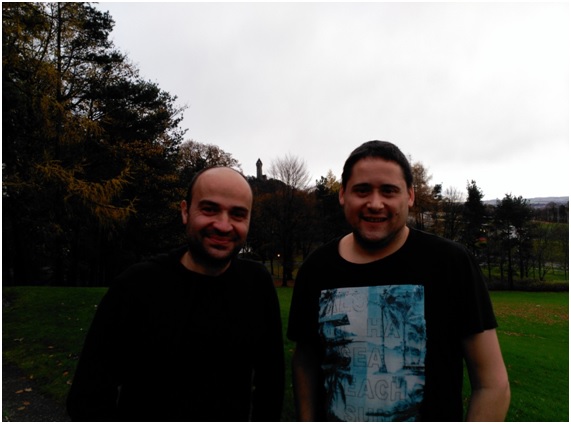
Period from 03/08/2015 to 02/11/2015
Full name: Diego Lorenzo Garrido
Home Institution: Spanish Institute of Oceanography (IEO), Oceanographic Centre of Canary Islands, Santa Cruz de Tenerife, Spain.
Host Institution: Institute of Aquaculture, University of Stirling, UK.
STSM Summary Report
Research Interest: Molecular and functional characterization and assessment of expression of genes involved in lipid metabolism in Octopus vulgaris.
Summary of research completed during STSM: The molecular and functional characterisation of two desaturases (termed here as “desaturase 1” and “desaturase 2”) was performed in common octopus Octopus vulgaris. Additionally, the expression of genes involved in fatty acid biosynthesis in Octopus vulgaris in adult specimens and paralarvae fed on Artemia enriched with a novel enrichment diet based on marine phospholipids was also studied during this STSM. Two full-length sequences with homology to desaturases were cloned from Octopus vulgaris. The first desaturase had been partly cloned by the host researcher Dr Oscar Monroig prior my visit. Moreover, a second desaturase was also identified during my visit to the host institution. After cloning the two putative desaturase, we studied their function by expressing their open reading frames (ORF) in yeast Saccharomyces cerevisiae.
We are currently processing the analysis on the molecular and functional characterisation of the two newly cloned desaturases. However, preliminary results on gene expression have shown that eye displayed the highest levels of expression of both desaturases among all the O. vulgaris tissues studied, with nerve ranking second. This is in agreement with existing literature confirming that neuronal tissues accumulate significant amounts of long-chain polyunsaturated fatty acids, the metabolic products of the investigated enzymes.
Regarding the paralarvae feeding trials, our results suggest that the genes encoding desaturases (∆9, ∆5, desaturase 1 and desaturase 2) and elongases (Elovl 5 and Elovl 4) involved in polyunsaturated fatty acids (PUFA) biosynthesis of O. vulgaris paralarvae can be nutritionally regulated to some extent. Further analyses will clarify whether significant differences exist among treatments or not.
Synthesis and application of research: The molecular and functional characterisations of newly cloned desaturases will allow us to improve our knowledge on the lipid metabolism of O. vulgaris as well as their tissue distribution in adult octopus. These investigations are key to elucidate the essential fatty acids in O. vulgaris and thus allow to design diets that do not compromise the physiological requirements for normal growth and development in captivity. In addition, the investigation of regulatory mechanisms of these genes through the diet can facilitate the establishment of practical strategies (e.g. diet formulation) to optimise the PUFA endogenous synthetic capability.
Wider benefit of the STSM to the participant: I have had the great opportunity to enjoy an STSM at the Institute of Aquaculture, University of Stirling, UK, and work under the supervision of Dr. Oscar Monroig. It has been my first experience with molecular biology, methodologies used increasingly often in the context of aquaculture research. Besides, the results achieved during this stay will allow us to improve our knowledge of lipid metabolism in Octopus vulgaris, what may be helpful to better understand the nutritional problems associated to this species mortality during early stages of development.
Key output: An immediate outcome of this visit will be the preparation of a manuscript that will be soon submitted for publication in a peer-reviewed journal. The results, while preliminary, appear to be very interesting and novel, so we believe this will led us to continue this research in the near future and explore for additional funding streams to strengthen our collaboration.
Dr. Federica Maiole:Effect of the exposure of Sepia officinalis embryo specimens to a pesticide: AChE as biomarker?
Show More/Less

Period from 31/08/2015 to 30/09/2015
Full name: Federica Maiole
Home Institution: Center for Synaptic Neuroscience (NSYN) & IIT – Istituto Italiano di Tecnologia
Host Institution: Groupe Mémoire et Plasticité comportementale Université de Caen Normandie
STSM Summary Report
Research Interest: Investigation of cephalopod arm structure and development.
Summary of research completed during STSM: During my STSM I investigated the effect of one OP (chlorpyrifos) exposure on cuttlefish (Sepia officinalis) embryos aiming to assess the use of AChE as a biomarker for sepia OP exposure. Amongst OPs, Chlorpyrifos has the potential to bio-accumulate and, despite its low water solubility, is found in surface waters including seawater. According to the Directive 2013/39/EU, the maximum allowable concentration (MAC) limit for chlorpyrifos is 100 ng/L. Nevertheless, the Environmental Quality Standard (EQS) (as annual average) for chlorpyrifos in superficial water is exceeded. In Italy, for example, 0.3 μg L−1 of chlorpyrifos was found in water samples following vineyard application (Capri et al, 2005). First, I set up a multi-containers apparatus to expose individually cuttlefish eggs/hatchlings to the pesticide so that Temperature and Oxygen percentage in beakers remain stable during the treatments. Sepia officinalis eggs and hatchlings of the previous 24 hours have been exposed to the pesticide chlorpyrifos through bath exposure and injection through the eggshell. 6 experimental groups were used: 2 different controls, filtered seawater and filtered seawater plus DMSO (0,01%) to test whether DMSO had an impact on the development; 4 different concentrations of the pesticide (dissolved in filtered seawater with 0.01% DMSO): 0.01µM = 3,5 µg/l, 0.1 µM = 35 µg/l, 1 µM = 350 µg/l, 10 µM = 3,5 mg/l. The eggs were bath exposed to the pesticide or chlorpyrifos was injected through the eggshell and after 24 hours were opened. On the other hand, hatchlings were bath exposed, keeping them in the solutions for 24 hours. Embryos and hatchlings were anaesthetised in seawater containing 2% of ethanol and 17,5 gL-1 of MgCl2, fixed and have been shipped to Genova. The fixed tissue were serially sectioned on a cryostat at 20 μm. Acetylcholinesterase detection has been performed following the method of Karnovsky and Roots (1964). AChE RNA in situ hybridization has been carried out on sections using a procedure slightly modified from Tiveron et al., 1996 with an Octopus vulgaris acetylcholinesterase probe. Unexpected death of both untreated control and treated animals was recorded, so further studies are needed to examine the effect of the organophosphate chlorpyrifos exposure on early developmental stages of Sepia officinalis; acquired data show that the pesticide determine a reduction of maximum arm length, diameter and optic lobe area and a decrease of AChE activity. We thus suggest that AChE can be used as a biomarker of chlorpyrifos exposure in cuttlefish.
Synthesis and application of research: The main aim of this STMS was to assess the use of AChE as a biomarker for OP exposure in cuttlefish. During my STSM we set a protocol to expose individually cuttlefish eggs/hatchlings to waterbone contaminants. Those eggs/hatchlings have been exposed to different concentration of an organophosphate pesticide, chlorpyrifos, and then humane killed. Maximum arm length, diameter and optic lobe area have been measured and Chlorpyrifos 10 μM seems to lower the morphogenesis rate. AChE expression and its mRNA localization have been detected and preliminary data show that AChE activity was found to be decreased in cuttlefish exposed to chlorpyrifos.
Wider benefit of the STSM to the participant: I believe that the participation to this project in Dr. Bellanger working group strengthen both my theoretical knowledge of Cephalopod biology and my Cephalopod experimental handling ability. As an added value I had the opportunity to network with other students and professional from a different country, which is an exceptional opportunity for direct exchange of experience. This activity also led to a strengthening of the collaboration between the host and my home institution.
Key output: Chlorpyrifos treatment determines a decrease of AChE activity both in eggs and hatchling optic lobes; we suggest AChE as a biomarker for organophosphate compounds.
Dr. Silvia Lourenço: Application of Molecular Analysis of Trophic Interactions (MATI) methodologies to study the diet benthopelagic squids
Show More/Less
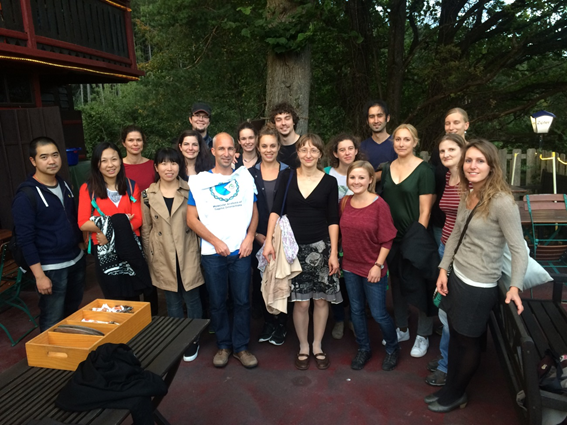
Period from 01/09/2015 to 30/09/2015
Full name: Sílvia Alexandra Pereira Lourenço
Home Institution: Department of marine resources, Instituto Português do Mar e da Atmosfera
Host Institution: Mountain Agriculture Research Unit, Institute of Ecology, University of Innsbruck
STSM Summary Report
Research Interest: The application of molecular analysis to study the trophic role of pelagic and benthopelagic squids in the marine food-web have a great potential.
Summary of research completed during STSM:
The short term scientific mission on the Mountain Agriculture Research Unit at the Institute of Ecology (University of Innsbruck) had two objectives. Firstly, to learn the molecular tools and methodologies used to study the diet of generalist predators; and secondly, to evaluate the possibility of using MATI approach to study the role of the squid in the pelagic food-web. During my STSM, I was tutored by MSc Zhenpey Ye, Dra Daniela Sint and Dr Michael Traugott on all the techniques associated with the MATI approach. Using Todarodes sagittatus as species model, I learned the techniques and applied diagnostic PCR to identify the main prey to that species. The methods used included: the DNA extraction from the squid and from their gut content; Squid DNA amplification and sequencing; Gut content DNA amplification using diagnostic single-plex PCR using group specific primers for fish, crustaceans, isopods and amphipods; Sequence analysis and primers quality check. The results were not conclusive but allowed to define a methodology to study the role of the squid in the pelagic food-web based in a multidisciplinary approach by applying the stomach content analysis together with next generation and diagnostic PCR.
Synthesis and application of research: The pelagic and benthopelagic squids have an important ecological role in the marine ecosystem. They are important forage species of top predators and generalist consumers of macrozooplankton, crustaceans, small fishes and cephalopods. Most of the studies on the diet of the squids are based on the analysis of the stomach content. However, that approach is biased by the presence of prey hard-parts in the stomachs, the feeding behaviour of the squids and fast digestion rates resulting of a high number of empty stomachs. The use of molecular analysis to study the diet of generalist predators overcomes these issues, and already has been applied to some cephalopod species. MATI has several advantages including the high sensitivity in prey identification that can be achieved, the relatively low cost and the rapidity in having results after essay design and experience setup. However, some limitations arise related with the impossibility of identifying consumers’ cannibalism, secondary preying or prey abundance determination.
Wider benefit of the STSM to the participant: During my STSM I had the opportunity to attend to the MATI course focusing in the methodology that I had been learning. The course focused in the presentation of different molecular analysis methodologies used to study trophic relationships namely feeding and parasitism. One important aspect of the course was the last seminar where students were challenged to present a MATI approach to their research questions. This seminar was very important to me because it helped to approach to my research question differently and to discuss it with both the supervisors as well as colleagues of different research fields, bringing up other view to the project. Other positive aspect of my STSM was the fact that I received a lot of information and advice about sampling procedures, benefits-costs associated with all the techniques applied and how to address these aspects in grants and projects proposals.
Key output: The learning experience. The definition of a methodology to study the role of the squid in the pelagic food-web.
Dr. Martim Magro: The use of selected biomarkers to assess the health of octopus paralarvae at different temperatures
Show More/Less
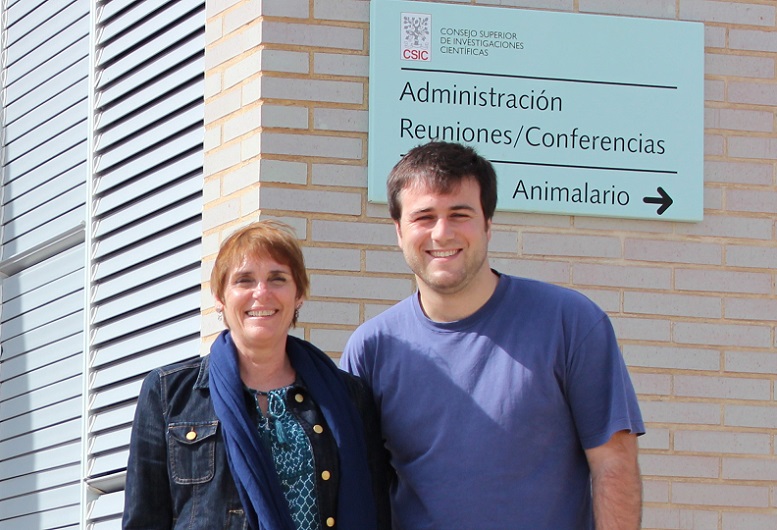
Period from 11/05/2015 to 30/06/2015
Full name: Martim Magro
Home Institution: Universidade do Algarve, Faro, Portugal
Host Institution: Instituto de Acuicultura de Torre de la Sal (IATS-CSIC), Castellón, Spain
STSM Summary Report
Research Interest: To develop the commercial culture of Octopus vulgaris. Selection of biomarkers in order to characterize the effect of the temperature in the early development stages of O. vulgaris.
Summary of research completed during STSM: This study was focused to understand how different incubation temperatures (19 and 22ºC) applied during the embryonic development can affect the viability and health of the O. vulgaris paralarvae. Selected biomarkers related with growth (RNA/DNA ratio), thermal stress (heat shock protein-HSP70), detoxification (glutathione-S-transferase- GST) and neurotransmission (acetilcholinesterase-AChE) were analyzed in paralarvae at different ages (0, 7 and 14 days after hatching-DAH). One individual per sample was used for all analysis, except for HSP70 (7-8 paralarvae per sample). After 14 days of culture, the paralarvae obtained from the eggs incubated at lower temperature (19ºC) showed a higher specific growth rate, but lower survival than paralarvae from 22ºC group. Regarding the biomarkers analysed, the RNA/DNA ratios were similar in both treatments and showed a significant increase between 0 and 14 DAH, regardless of the incubation temperature. HSP70 expressions were similar at newly hatched and 14 DAH paralarvae between both treatments, but at 7 DAH the group maintained at 22ºC showed a sharp rise respect to 19ºC group (12.49 vs 4.96 AU/ng prot respectively). GST levels showed a tendency to higher levels in 19ºC group respect to 22ºC, but the high variability obtained hindered significant differences between both groups. The higher value of AChE was reported in newly hatched paralarvae incubated at 22ºC, but, in similar ways to the GST results, there were no significant differences among groups due to the high variability observed. The results confirm the effect of the incubation temperature applied during the embryonic development in the paralarval viability, but the HSP70 expression was the only biomarker significantly affected by the incubation temperature. In addition, RNA/DNA ratios and HSP70 expressions seems to be also affected by the age of the paralarvae. The high variability obtained in GST and AChE determinations hampered potentials significant differences among treatments. In consequence further studies are necessary to clarify the influence of the incubation temperature in these biomarkers.
Synthesis and application of research: Incubation temperature along the embryonic development in Octopus vulgaris affects the viability and physiology of the paralarvae. Biomarkers could be a useful tool in order to comprehend and contribute to solve the problems associated to eggs incubation and paralarval rearing of this species. The results obtained could have applications for the future of the O. vulgaris culture.
Wider benefit of the STSM to the participant: During my STSM, I learn new laboratory techniques and data treatments, increasing my professional experience. The results obtained allow me to think about future projects with the host institution in order to go deeper in the biomarkers analyses to improve our knowledge in the physiology of the first stages of the common octopus Octopus vulgaris.
Key output: Results from this work are planned to be published in a peer review scientific journal specialized in the area of aquaculture or animal physiology.
Dr. Joana Moura: Study of the expression of different genes of the polyunsaturated fatty acid metabolism of octopus paralarvae (Octopus vulgaris) through quantitative PCR (qPCR)
Show More/Less
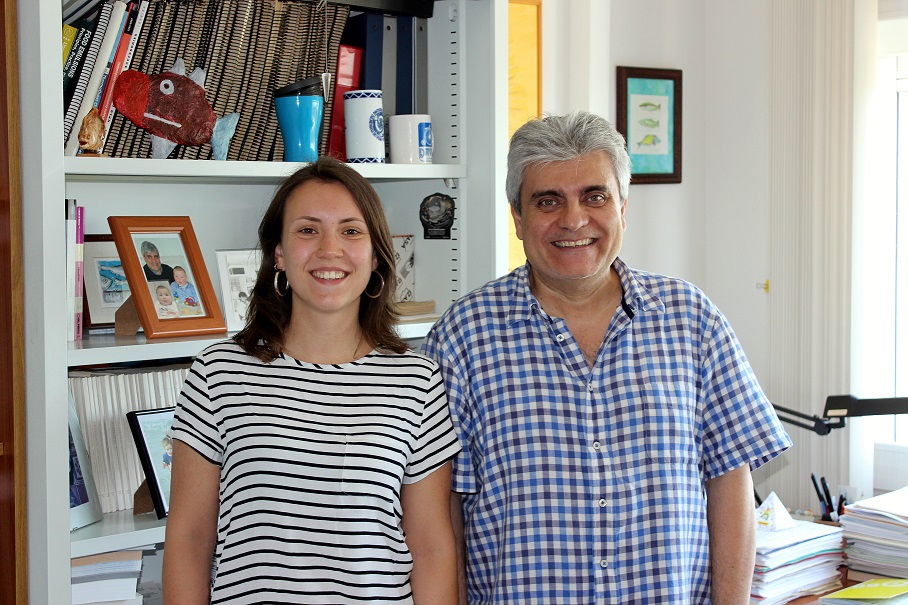
Period from 11/05/2015 to 03/07/2015
Full name: Dr. Joana Moura
Home Institution: Universidade do Algarve, Faro, Portugal
Host Institution: Instituto de Acuicultura de Torre de la Sal (IATS-CSIC), Castellón, Spain
STSM Summary Report
Research Interest: Contribute to solve the problem associated to the culture of the common octopus (Octopus vulgaris). To study the lipid requirements of the paralarvae through the analysis of genes involve in the lipid metabolism.
Summary of research completed during STSM: During my stay in the Instituto de Acuicultura de Torre de la Sal (IATS-CSIC, Spain) and together with Dr. Francisco Hontoria, my STSM consisted in a training to learn molecular biology techniques, which were further applied to the study of the expression of the genes scd, fad, elovl5 and elovl4, involved in the metabolism of long-chain polyunsaturated fatty acids (LC-PUFA) of the common octopus (Octopus vulgaris) paralarvae. One of the main causes pointed for the high mortalities observed in the first days of cultivation of the octopus paralarvae is the absence of an appropriate diet that fulfil all the nutritional requirements of paralarvae. The case of LC-PUFA, biosynthesized by enzymes called elongases and desaturases, are considered key factors for a suitable growth during the planktonic life of octopus. In this sense, we developed a study to measure the expression of the genes encoding for the enzymes Stearoyl-CoA Desaturase with ∆9 activity (Scd), Fatty acyl desaturase with ∆5 activity (Fad) and Elongases of Very Long-Chain fatty acids 4 and 5 (Elovl4 and Elovl5), through quantitative PCR (qPCR) using the β-actin gene as reference. These genes, already characterized in adult octopus, were now analyzed at days 0 (hatching), 5, 10, 15 and 20 of paralarval development. The analysis of the results revealed that all genes are present in the RNA of octopus paralarvae in all age samples (days 0, 5, 10, 15 and 20) and an increase of the expression in paralarval sample from day 0 until day 20 is observed, with the exception of the genes scd and elovl5 at hatching. This tendency could suggest that paralarvae increase their capacity of biosynthesizing these enzymes while the development and the complexity associated to the growth also increase, although further research is necessary to ascertain this point.
Synthesis and application of research: The knowledge of the presence and expression of the lipid metabolism genes scd, fad, elovl4 and elovl5, previously characterized in adult octopus (Octopus vulgaris), and now studied for the first days in paralarvae development, is a contribution to solve the problems associated to the culture of this complex species. This advance could have applications for the future of its aquaculture.
Wider benefit of the STSM to the participant: During my STSM, I was able to learn new techniques in the laboratory, increasing my professional experience. This collaboration, allow me to create a new contact with an excellent researcher, Dr. Francisco Hontoria and his team. This experience, made feel that I could give another contribution to science, more specifically for aquaculture, which is one of my passions.
Key output: Results from this work are planned to be published in a peer review scientific journal specialized in the area of research, as soon as possible.
Dr. Raquel Vizcaino Lence: Selection of non-invasive biomarkers from skin mucus as candidates of welfare and health assessment for the common octopus Octopus vulgaris
Show More/Less
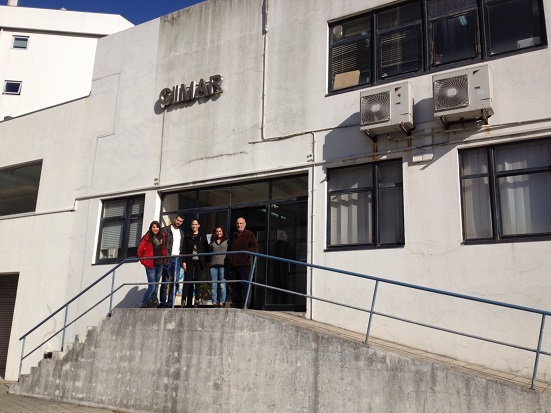
Period from 15/09/2015 to 30/10/2015
Full name: Raquel Vizcaino Lence
Home Institution: Molecular Pathobiology group, IIM – CSIC (Instituto de Investigaciones Marinas – Spanish National Research Council), Vigo, Spain.
Host Institution: Fish Nutrition and Immunobiology group, CIIMAR (Interdisciplinary Centre of Marine and Environmental Research), NUTRIMU group, Porto, Portugal.
STSM Summary Report
Research Interest: Selection of non-invasive biomarkers as candidates of welfare and health assessment for the common octopus (Octopus vulgaris) in skin mucus.
Summary of research completed during STSM: Eight common octopuses (Octopus vulgaris) were collected on 30th September 2015 at the Vigo estuary using fishing cages by professional certificated fishermen. Those individuals were transported in proper containers to the Experimental Culture Facilities of IIM-CSIC, institution registered as “User and breeding center on animal experimentation” ES360570202001. A group of 8 wild octopuses with an average weight of 1 Kg (from 0.96 to 1.3 Kg) were catch by accredited fishermen and transported to the wet facilities (IIM-CSIC, Vigo, Spain). Thereafter, those individuals were separated into two groups of 4 octopuses each. One of those groups comprised four octopuses held in single tanks according to standard conditions, provided with shelter and with freedom in their movements, whereas the four octopuses from the other group were reared together in the same tank, inside a net and without allowing free movements. Since lack of territoriality and free movements are considered to cause stress, this second group of octopuses was regarded as chronically stressed animals. Samplings were carried out in the arrival day and, after five days of acclimatization time, every three days, until 17th September 2015. Skin mucus samples were collected from each animal by gentle squeezing and scraping the arms’ skin surface; sampling procedures were always performed after 20-30 minutes in anesthesia conditions (ethanol C2H5OH 1% + MgCl2 0’011 g/mL dissolved in sea water) to reduce distress (Fiorito et al., 2015). Samples were kept at -20°C until further analyses at the CIIMAR facilities. The following immune-related activities were measured in the common octopus skin mucus: lytic enzyme activities (anti-protease, protease, lysozyme and peroxidase activities), total proteins, alternative complement and bactericidal activities were evaluated by spectrosphotometric analysis. As summary results, crowding stressful conditions in O. vulgaris causes a decrease in most of the parameters measured only after 11 days, while alternative complement activity was immunosuppressed until the end of the trial. Contrarily, peroxidase and bactericidal activity against Tenacibaculum maritimum increased after eleven days, which suggest that these parameters could be related since peroxidases are important microbicidal agents. Considerable more detailed results are described in the below “Key outputs” section, but in summary these preliminary results suggest that protease, lysozyme, complement activity and bactericidal activity could be selected as potential candidates to biomarkers of welfare and health assessment for the common octopus using skin mucus. Nevertheless, further studies are needed to confirm this hypothesis and to better understand the effect of stress on the mucosal immune response of common octopus.
Synthesis and application of research: The general objective was to improve our knowledge on molecules related to mucosal immunity in cephalopods. This project aimed to study immune parameters in the skin mucus of Octopus vulgaris exposed to stressful conditions. It was hypothesized that chronic stress modulates the immune system. Immune parameters could be potential biomarkers to be used as non-invasive welfare indicators, in order to identify stressed and immune-compromised cephalopods. Skin mucus would be an ideal source of biomarkers because their sampling is non-invasive, in accordance with the 3Rs principles These biomarkers are needed in research, aquaculture and fisheries of this species, since cephalopods have been included in the new European Directive on animal protection.
Wider benefit of the STSM to the participant: The STSM made possible the survey explained previously, which enriched me in many senses, personally and professionally: I have won research experience, currently I can affirm that I have got the capacity of independent thinking and the ability to carry out an original research from the beginning until the end, not just perform the laboratory techniques needed. In addition, it was a great collaboration since the host group has a remarkable previous experience in skin mucus in several fish species which was really valuable at the time of carrying out the experiment, having always a skilled scientist who guided me in moments of doubt and teaching me immunology techniques that I did not know before. On the other hand, I have adapted myself to a different laboratory group and enhance my team work and learning diverse ways to solve common problems. I should point out that the group was international, with the consequently practice of foreign languages, some of them completely new, as Portuguese. The fact of meet new people will give me the opportunity of future collaborations, which I have described in the other report submitted.
Key output: The main conclusions of this survey were the following:
- The analysis of immune parameters in skin mucus is a valid non-invasive method for the study of biomarkers of stress in Octopus vulgaris.
- The stress starts to be detected after five days under crowding and limited movements conditions and continued until day fourteen. On the seventeenth day no differences were observed in most of the parameters measured.
- The preliminary results obtained in this survey suggest that, among the immune parameters measured, peroxidase activity in skin mucus could be a potential biomarker of welfare and health to be further studied.
Dr. Nir Nesher: Neurophysiological research in cephalopods, Octopus arm neuromuscular junction structure
Show More/Less
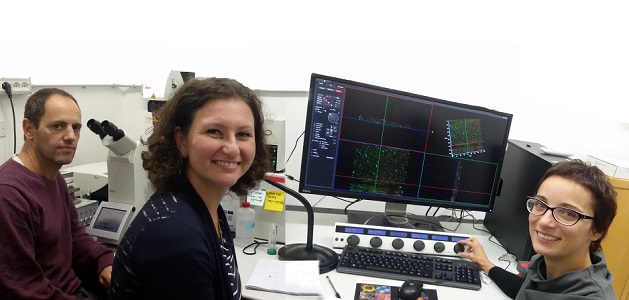
Period from 04/10/2015 to 17/10/2015 and from 14/08/2016 to 30/08/2016
Full name: Nir Nesher
Home Institution: 1. Department of neurobiology, Alexsander Silberman Institute of Life Sciences, The Hebrew University of Jerusalem, Edmond J. Safra Campus, Givat Ram, 9190400 Israel
2. School of Marine Sciences, Ruppin Academic Center, Emek-Hefer 4025000, Israel
Host Institution: Fondazione Istituto Italiano di Tecnologia, IIT Italian Institute of Technology
Neuro-Synaptic Dept (NSYN)
Largo Rosanna Benzi, 10, Torre D1
16132 Genova, Italy
STSM Summary Report
Research Interest: Characterization of the spatial pattern of muscle cells innervation in the intrinsic musculature of the Octopus vulgaris arm.
Summary of research completed during STSM: Motor control of the octopus arm movement is a challenging task. This arises from the virtually infinite degrees of freedom which need to be controlled. The arms can bend in any direction, elongate, shorten, and twist at any point along their length. In addition, the octopus body lacks almost entirely any rigid parts and therefore it uses its muscles both for creating a stiffened skeletal-like structures and for generating power in order to create motion. The neuromuscular system must be able to provide the two distinct muscle functions and to control this hyper redundant and flexible body configuration. Electrophysiological experiments suggested that each myocyte receives three distinct cholinergic excitatory synaptic inputs. This implies that every cell is innervated by three different neural nets to trigger the different muscle functions. However, the exact pattern of muscle innervation are unknown. In order to understand the muscles pattern of innervation in Octopus vulgaris arms, we stained fresh and fixed sections with various staining methods. We used only freshly deceased specimens of Octopus vulgaris that were bought from the local fish market on the morning of the experiment day. Transverse and longitudinal arm segments were taken at various locations along the arm length. Some of the samples were fixed for 4h in 4% Paraformaldehyde in artificial sea water, then cut in 30-60 micrometers thick segments. The other samples were cut fresh in100-200 micrometers thick. The specimens were then used for staining procedures. We succeeded in staining the acetylcholine receptors with α-bungarotoxin conjugated to ATTO-633 (Alomon labs, Cat’ B-100-FR) in both fresh and fixed tissues. The receptors are concentrated in an eye shape invagination (≈5X20µm) in the cell membrane. The pattern appear to be in accordance with our previous staining of ACh receptors in isolated octopus arm muscle cells. Staining with Retrograde neuronal tracers, DIL (Invitrogen, Cat’ D-282) resulted in good pre-synaptic staining after 10 days of exposure, but showed very fast bleaching during microscopic inspection. Results obtained using the anti-β-III-Tubulin (Sigma T2200) were poor. The best pre-synaptic staining was obtained using 4–Di–2–ASP ([4-(4-Diethylaminostyryl)-N-methylpyridinium-iodide], AnaSpec, Cat’ AS-88052). The staining pattern may suggests that every three nerve ending converge to a single site, most likely the NMJ of a cell. These findings corroborate with the physiological phenomenon described above regarding the three distinct synaptic inputs which excite a muscle cells. The double staining of 4–Di–2–ASP with the α-bungarotoxin-ATTO-633 produced good results. However, these are still in the preliminary stage.
Synthesis and application of research: The lack of a rigid skeleton enables the octopus to deform its arm into a huge number of structures and to perform both simple and highly complex movements. However, controlling such extremely flexible organ requires a highly sophisticated motor control system. Previous neurophysiological data implies that every single muscle cell is controlled by three distinct nerve systems (Matzner et al., 2000). By the use of various staining procedures of post and pre-NMJ, our work contributes visual data of muscle innervation and supports the physiological evidence for the existence of three distinct motor control nerve nets that control the muscles cells functions.
Wider benefit of the STSM to the participant: The STSM gave me the opportunity to investigate a hypothesis based on previous electrophysiology data from a different view angle, and to use additional approaches (i.e. various staining methods and confocal microscopy) which are not available at my home laboratory. Indeed, the results confirm the reproducibility and value of this approach and its contribution to our understanding of the unique motor system and motor control of the octopus arm.
Key output: A scientific publication of the work is planned to be submitted to a peer reviewed scientific journal. The collaboration achieved during this STSM has founded the ground for a future collaboration on this subject in the future.
Dr. Gabriella Scata: Effect of water depth of housing/rearing tank on cuttlefish welfare
Show More/Less

Period from 30/09/2015 – 24/12/2015
Full name: Gabriella Scata
Home Institution: Ben Gurion University of the Negev, Eilat campus, Eilat, Israel
Host Institution: University of Caen Normandie, Groupe mémoire et plasticité comportementale (GMPC)
STSM Summary Report
Research Interest: We investigated the effect of water depth on cuttlefish welfare and the use of vertical space by cuttlefish.
Summary of research completed during STSM:
Study A)
We investigated the effect of water depth on cuttlefish welfare. Twelve cuttlefish Sepia officinalis were randomly assigned to two depth treatments, with similar water volume, for 2 months: “shallow” and “deep”, 8 and 20 cm water depth, respectively (Fig. 1). Feces were collected daily for corticosteroid analysis. Animals’ pictures were taken from above to estimate growth rate as increase in dorsal mantle length.
The animals were subjected to three behavioral experiments: i) cognitive bias experiment, to test for optimistic/pessimistic attitude ii) exploration experiment, to test for anxiety-related behaviors, and iii) boldness experiment.
I) Cognitive bias experiment
The animals of the two groups (shallow and deep) were first pre-trained to approach a grey cue in order to obtain food, and then trained to discriminate between a white-positive and a black-negative cue, (or viceversa, randomly preselected for each animal). The animals were then tested with an ambiguous stimuli, a striped white and black cue (Fig. 2). We recorded the latency to approach the cue and the choice made by the animal (approach/not) during training and testing.
II) Exploration experiment
Each animal was individually placed in a starting home tank for one hour. Afterwards, the home tank door was removed and the animal was allowed to enter the exploration tank. The time taken by the animal to exit the home tank was recorded and used as a measure of boldness. We analyzed the total distance travelled by the animal, the amount of time spent not moving, close to the walls or in the shelters.
III) Boldness experiment
The animal was presented with a shrimp on a stick. When the animal had approached the shrimp, a fake bird’s head was presented above the shrimp. We recorded the latency to approach the shrimp before and after the presentation of the bird.
Study B)
We investigated the use of vertical space by cuttlefish. Two glass tanks were used: a shallow and a deep tank (13.5 cm and 40.1 cm water depth, respectively, same total water volume). Six identical shelters were placed in each tank, arranged on top of each other to have shelters at different heights. Five animals were placed in each tank. Videorecordings of the animals’ movements were carried out at night with the use of infrared lights. We assessed the amount of distance moved by each animal in the horizontal and vertical plane and the use of shelters at different heights.
Synthesis and application of research: this provides a short summary/abstract of the main aims and outcomes of the STSM and will be utilized as metadata for googlebility and dissemination purposes of research;
We studied the effect of water depth on cuttlefish welfare and vertical space occupancy by cuttlefish. No effect of water depth was found on cuttlefish boldness, anxiety or emotional behaviour (pessimistic/optimistic attitude). However, a water depth greater than the tested one may still have a positive effect on cuttlefish welfare. We showed that cuttlefish i) move gradually upwards and spend most of the time in the upper water level at night; and ii) use shelters at different heights. The effect on welfare of vertical space accessibility should be further investigated and should be considered when designing housing tanks for cuttlefish.
Wider benefit of the STSM to the participant: This STSM allowed me to learn further methods and techniques for the study of animal behavior and for training animals. In addition, I gained further experience on working with cephalopods, which will be beneficial for me during my PhD research on squids.
Key output: A method for the study of cognitive bias in cuttlefish was tested for the first time. An increase in water depth from 8 to 20 cm only does not cause an obvious effect on cuttlefish welfare. Cuttlefish do use the vertical space, moving upwards at nighttime. This natural behavior is limited and reduced when the animals are housed in a very low water level. Animals housed in lower water seem to spend less time in the upper water level than animals housed in higher water. Cuttlefish use shelters at different heights, even those which are way above the bottom of the tank.
Dr. Pamela Imperadore: Contribution to the development of the cephalopod welfare index
Show More/Less
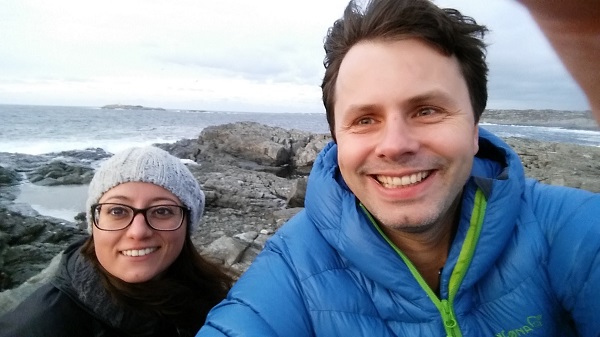
Period from 04/11/2015 to 04/12/2015
Full name: Pamela Imperadore
Home Institution: Association for Cephalopod Research – CephRes, Napoli (IT)
Host Institution: Institute of Marine Research (IMR, Havforskningsinstituttet), Storebø (NO)
STSM Summary Report
Research Interest: Mechanisms involved in peripheral nerve regeneration taking advantage of the cephalopod mollusc Octopus vulgaris; animal welfare
Summary of research completed during STSM: In compliance with the Directive 2010/63/EU, assessing and maintaining adequate the welfare status of an animal is essential for assuring the best care for any use (invasive or non-invasive) of an animal for experimental, scientific or educational purposes. According to the Directive any event which may cause the animal a level of pain, suffering or distress or lasting harm equivalent to, or higher than, that caused by the introduction of a syringe needle according to good veterinary practice, has to be regulated and impact minimized. To assess animal welfare, it is necessary to establish observable and measurable indicators of the degree of fulfilment of their needs. Very little is, however, known on how to correlate behavioural, physiological, neural needs of cephalopods in relation with stress and/or welfare. The development of a system of weighting and scoring levels of “welfare indicators” is therefore one of the key objectives of the COST Action FA1301 Working Group 4 (Development of a Cephalopod Welfare Index). To achieve this goal the construction of a database of welfare relevant scientific statements is mandatory. During the four weeks of my stay at the Institute of Marine Research (Norway) I was trained to identify from scientific literature statements relevant to cephalopod welfare assessment. I reviewed scientific literature (hatchling and adult of Octopus vulgaris) to extract welfare statements and assign them to a list of needs. More than 80 scientific papers were analysed from which I extracted around 300 statements. I also prepared a preliminary list of welfare indicators, linked them to appropriate weighting categories and calculated their weighting score.
Synthesis and application of research: The work carried out at the Institute of Marine Research in Norway allows WG4 to start creating a cephalopod welfare index model (for Octopus vulgaris) through the identification of specific welfare indicators, needs and weighting categories. This preliminary attempt will be reviewed and aimed to impact the modality of welfare assessment for cephalopod housed in facilities for scientific, educational and public display purposes.
Wider benefit of the STSM to the participant: This STSM represented a great opportunity to work side by side with researchers that developed the Welfare Index Model (originally designed for salmons), a semantic model for overall welfare assessment. In addition, this experience was an invaluable chance to gain a deeper knowledge to conduct theoretical and practical analysis from grey-literature, and to test some of the approaches I may use in my future career.
Key output: The work carried out allowed us to enrich the database (http://www.imr.no/cephsinaction/index.htm), which reached a significant level of completion for temperature, oxygen, stocking density, salinity, appetite and mortality based on adult O. vulgaris. We also started creating a Welfare Index Model for this species; drafting a first version of a manuscript describing the model and the outputs of this STSM is also a significant output of this project.
| M | T | W | T | F | S | S |
|---|---|---|---|---|---|---|
| 1 | 2 | 3 | 4 | 5 | 6 | |
| 7 | 8 | 9 | 10 | 11 | 12 | 13 |
| 14 | 15 | 16 | 17 | 18 | 19 | 20 |
| 21 | 22 | 23 | 24 | 25 | 26 | 27 |
| 28 | 29 | 30 | ||||
This website is supported by COST, European COoperation in Science and Technology


